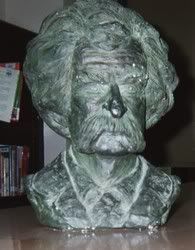A Hastily Conclusion.
I should have known this week was going to be busy. Monday the 13th. The most unlucky day of all.
Well it’s that magical time of the year again, finals week. *gag* . I got a ‘B’ on my paper in Honors Government regarding taxes under Bush. J Seeing as how I constantly visit this blog, I wondered if maybe by posting a sample of my poor excuse for notes here I would memorize them easier for the tests. Here goes nothin’. My only regret is that I cannot include any drawings or diagrams from my notes. Perhaps I should add a scanner to my Christmas list (yeah right).
· Valence Electrons: The outermost and most reactive electrons of an atom
· Ionization Energy: The energy required to remove an electron from an atom or ion in the gas phase.
· Atomic Radius: The approximate distance between atoms in a molecule
· Electron Affinity: The energy change occurring when an anion of the element in the gas phase loses an electron
· Effective nuclear Charge: The nucleic charge experienced by an electron in a multi electron atom, as it is modified.
By graphing the properties of elements I was able to determine that as you move from left to right across the periodic table of elements, effective nuclear charge and the number of protons increases. Atomic radii decrease as you move across periods, and electron shielding remains constant. For example, an atom of fluorine is smaller than an atom of Boron because while shielding (the number of core electrons) is constant, ENC has increased. Ionization energy also increases across periods because as ENC becomes greater more energy is required o remove valence electrons. In groups, or families, the trends above are reversed, shielding, increases because electrons are being added, however this time to higher energy levels. Effective nuclear charge is constant for families because subtracting the number of core electrons from the number of protons in an tom will always produce the number given at the top of the group that particular atom’s element belongs to, electrons and protons increases to allow this. Atomic radii increase from the top of a family to the bottom because shielding is increasing and ENC remains constant. Ionization energy decreases because as you move down a given family the distance (atomic radii) is increasing, the farther valence electrons of an atom are from the nucleus; the less energy is needed to remove them from orbital.
Well it’s that magical time of the year again, finals week. *gag* . I got a ‘B’ on my paper in Honors Government regarding taxes under Bush. J Seeing as how I constantly visit this blog, I wondered if maybe by posting a sample of my poor excuse for notes here I would memorize them easier for the tests. Here goes nothin’. My only regret is that I cannot include any drawings or diagrams from my notes. Perhaps I should add a scanner to my Christmas list (yeah right).
· Valence Electrons: The outermost and most reactive electrons of an atom
· Ionization Energy: The energy required to remove an electron from an atom or ion in the gas phase.
· Atomic Radius: The approximate distance between atoms in a molecule
· Electron Affinity: The energy change occurring when an anion of the element in the gas phase loses an electron
· Effective nuclear Charge: The nucleic charge experienced by an electron in a multi electron atom, as it is modified.
By graphing the properties of elements I was able to determine that as you move from left to right across the periodic table of elements, effective nuclear charge and the number of protons increases. Atomic radii decrease as you move across periods, and electron shielding remains constant. For example, an atom of fluorine is smaller than an atom of Boron because while shielding (the number of core electrons) is constant, ENC has increased. Ionization energy also increases across periods because as ENC becomes greater more energy is required o remove valence electrons. In groups, or families, the trends above are reversed, shielding, increases because electrons are being added, however this time to higher energy levels. Effective nuclear charge is constant for families because subtracting the number of core electrons from the number of protons in an tom will always produce the number given at the top of the group that particular atom’s element belongs to, electrons and protons increases to allow this. Atomic radii increase from the top of a family to the bottom because shielding is increasing and ENC remains constant. Ionization energy decreases because as you move down a given family the distance (atomic radii) is increasing, the farther valence electrons of an atom are from the nucleus; the less energy is needed to remove them from orbital.


0 Comments:
Post a Comment
<< Home